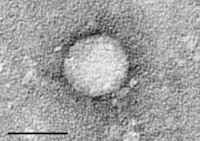
Photo from wikipedia
The hepatitis C virus nonstructural protein NS5A is involved in resistance to the host immune response, as well as the viral lifecycle such as replication and maturation. Here, we established… Click to show full abstract
The hepatitis C virus nonstructural protein NS5A is involved in resistance to the host immune response, as well as the viral lifecycle such as replication and maturation. Here, we established transgenic mice expressing NS5A protein in the liver and examined innate immune responses against lipopolysaccharide (LPS) in vivo. Intrahepatic gene expression levels of cytokines such as interleukin-6, tumor necrosis factor-α, and interferon-γ were significantly suppressed after LPS injection in the transgenic mouse liver. Induction of the C-C motif chemokine ligand 2, 4, and 5 was also suppressed. Phosphorylation of the signal transducer and activator of transcription 3, which is activated by cytokines, was also reduced, and expression levels of interferon-stimulated genes, 2’-5’ oligoadenylate synthase, interferon-inducible double-stranded RNA-activated protein kinase, and myxovirus resistance 1 were similarly suppressed. Since LPS binds to toll-like receptor 4 and stimulates the downstream pathway leading to induction of these genes, we examined the extracellular signal-regulated kinase and IκB-α. The phosphorylation levels of these molecules were reduced in transgenic mouse liver, indicating that the pathway upstream of the molecules was disrupted by NS5A. Further analyses revealed that the interaction between interleukin-1 receptor-associated kinase-1 and tumor necrosis factor receptor associated factor-6 was dispersed in transgenic mice, suggesting that NS5A may interfere with this interaction via myeloid differentiation primary response gene 88, which was shown to interact with NS5A. Since the gut microbiota, a source of LPS, is known to be associated with pathological conditions in liver diseases, our results suggest the involvement of NS5A in the pathogenesis of HCV infected-liver via the suppression of innate immunity.
Journal Title: PLoS ONE
Year Published: 2017
Link to full text (if available)
Share on Social Media: Sign Up to like & get
recommendations!